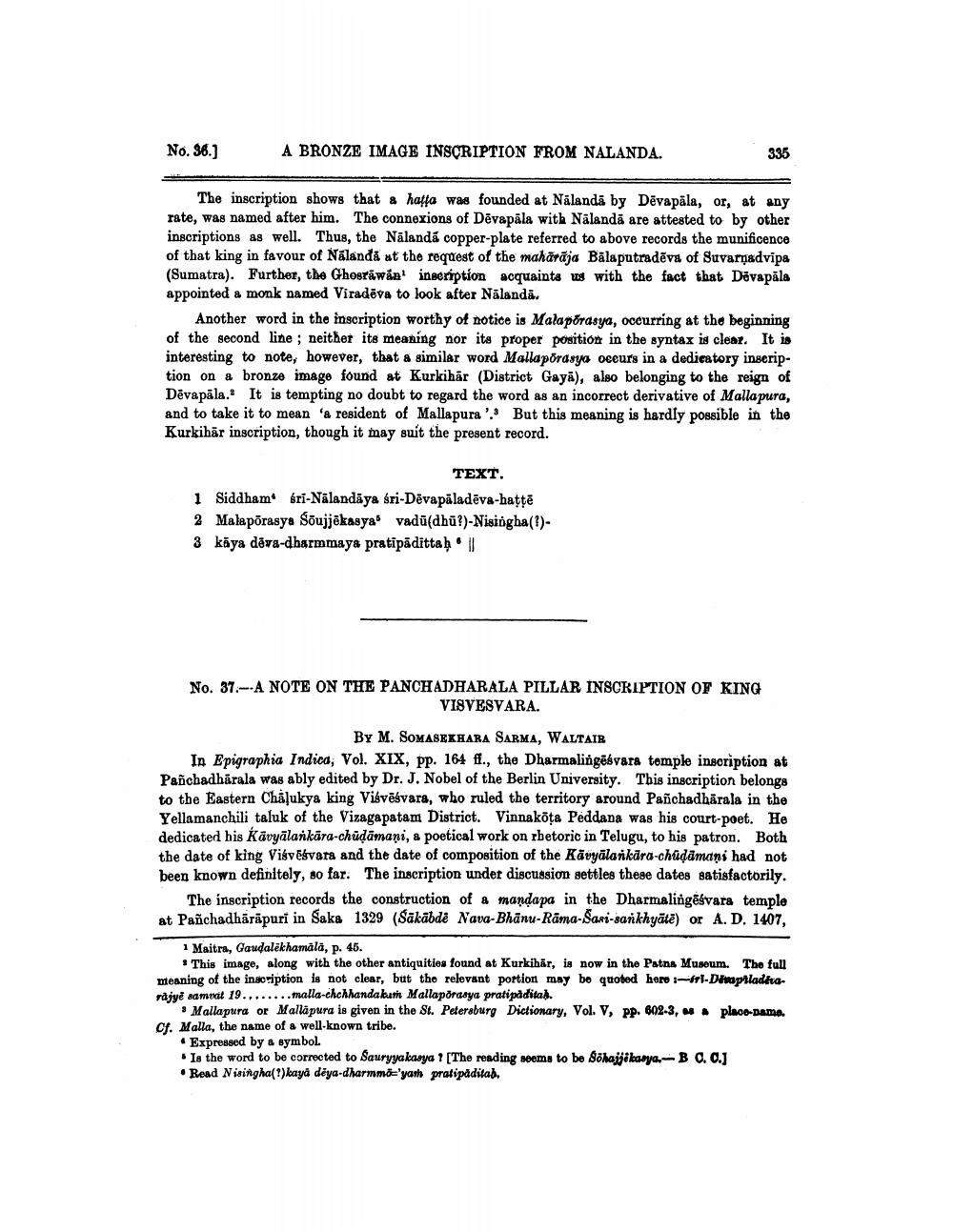________________
No. 36.]
A BRONZE IMAGE INSCRIPTION FROM NALANDA.
335
The inscription shows that a hata was founded at Nalanda by Dēvapāla, or, at any rate, was named after him. The connexions of Dēvapāla with Nālandă are attested to by other inscriptions as well. Thus, the Nalanda copper-plate referred to above records the munificence of that king in favour of Nalanda at the request of the mahārāja Bālaputradēva of Suvarnadvipa (Sumatra). Further, the Ghosriwin' inscription acquaints us with the fact that Dévapāla appointed a monk named Viradeva to look after Nalanda.
Another word in the inscription worthy of notice is Malaporasya, occurring at the beginning of the second line ; neither its meaning nor its proper position in the syntax is clear. It is interesting to note, however, that a similar word Mallapörasya oceurs in a dedicatory inseription on a bronze image found at Kurkihār (District Gayā), also belonging to the reign of Dėvapāla. It is tempting no doubt to regard the word as an incorrect derivative of Malla pura, and to take it to mean 'a resident of Mallapura '. But this meaning is hardly possible in the Kurkihār inscription, though it may suit the present record.
TEXT. 1 Siddhamsri-Nālandāya sri-Dēvapäladēva-battē 2 Malapõrasya Sõujjēkasya vadū(dhū?)-Nisingha(?)3 kāya dēva-dharmmaya pratipādittaḥ° /
No. 37.-A NOTE ON THE PANCHADHARALA PILLAR INSCRIPTION OF KING
VISVESVARA.
By M. SOMASEKHARA SARMA, WALTAIR In Epigraphia Indica, Vol. XIX, pp. 164 f., the Dharmalingēsvara temple inscription at Panchadhārala was ably edited by Dr. J. Nobel of the Berlin University. This inscription belongs to the Eastern Chalukya king Vibvēsvara, who ruled the territory around Panchadharala in the Yellamanchili taluk of the Vizagapatam District. Vinnakoța Peddana was his court-poet. He dedicated his Kavyālankāra-chūdāmaņi, a poetical work on rbetoric in Telugu, to his patron. Both the date of king Vitvēsvara and the date of composition of the Kävyalankara-chudamani had not been known definitely, so far. The inscription under discussion settles these dates satisfactorily.
The inscription records the construction of a mandapa in the Dharmalingēsvara temple at Pañchadhárāpuri in Saka 1329 (Sakābde Nava-Bhānu-Rama-Sari-sankhyātë) or A.D. 1407,
1 Maitra, Gaudalēkhamala, p. 45.
This image, along with the other antiquities found at Kurkihär, is now in the Patna Museum. The full meaning of the inscription is not clear, but the relevant portion may be quoted here - -Desaprladkarajye samrat 19........malla-chchhandakan Mallaporasya pratipaditah.
Mallapura or Mallāpura is given in the St. Petersburg Dictionary, Vol. V, pp. 602-3, place-Dama. Cf. Malla, the name of a well-known tribe.
• Expressed by a symbol
Is the word to be corrected to Sauryyakasya ? [The reading seems to be Söhajjökarya-B C.C.) • Read Nisingha(1) kaya dėya-dharmmo'yath pratipăditad.




